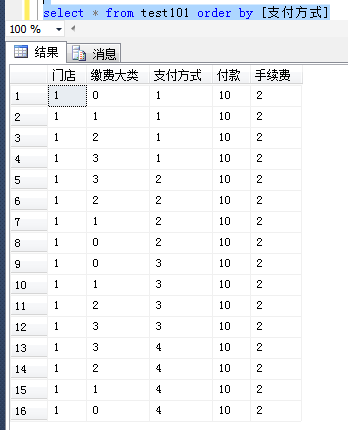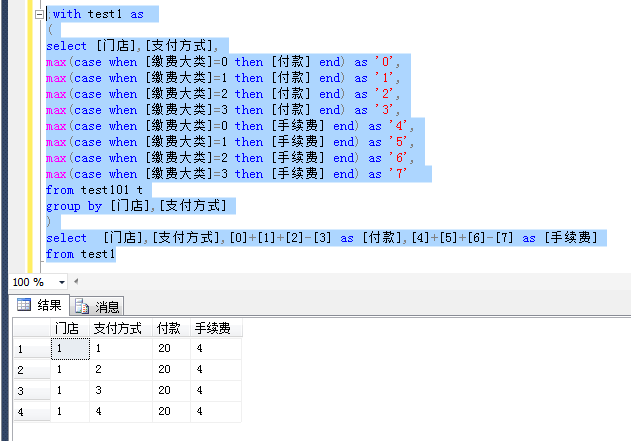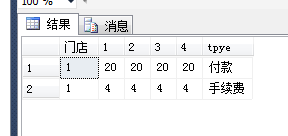碰到朋友一个问题,基于Oracle环境,有点复杂,直接看代码。
我的测试环境是sql server 2014
create table test101( [门店] int ,[缴费大类] int ,[支付方式] int ,[付款] int, [手续费] int ) insert into test101 values (1,0,1,10,2), (1,0,2,10,2), (1,0,3,10,2), (1,0,4,10,2), (1,1,1,10,2), (1,1,2,10,2), (1,1,3,10,2), (1,1,4,10,2), (1,2,1,10,2), (1,2,2,10,2), (1,2,3,10,2), (1,2,4,10,2), (1,3,1,10,2), (1,3,2,10,2), (1,3,3,10,2), (1,3,4,10,2)
数据如下:

然后是要求出挣得钱和缴多少税。
消费大类:3为退款,0~2为入账大类。
现在要计算每一种支付方式,挣了多少钱,缴了多少税。
逻辑算法:
挣钱:当支付方式为1时:累加支付方式0~2的付款数,减去消费大类为3(退款)的付款数,即为支付方式1所挣的钱。
手续费:当支付方式为1时:累加支付方式0~2的手续费,减去消费大类为3(退款)的手续费,即为支付方式1所需要承担的手续费。

挣钱:这里计算一下是10+10+10-10;

手续费:这里计算一下是2+2+2-2;
以此类推,算出每个门店下所有支付方式对应挣得钱和所需手续费。
方法:1(我朋友的方法,对此我是无比佩服),在实际业务中,肯定会有多条
[门店],[支付方式],[缴费大类]相同的,而付款和手续费不同的数据,所以实际业务中应当用sum代替max,这里只是测试就用Max了。
select [门店],[支付方式], max(case when [缴费大类]=0 then isnull([付款],0) else 0 end) + max(case when [缴费大类]=1 then isnull([付款],0) else 0 end) + max(case when [缴费大类]=2 then isnull([付款],0) else 0 end) - max(case when [缴费大类]=3 then isnull([付款],0) else 0 end) as [付款], max(case when [缴费大类]=0 then isnull([手续费],0) else 0 end) + max(case when [缴费大类]=1 then isnull([手续费],0) else 0 end) + max(case when [缴费大类]=2 then isnull([手续费],0) else 0 end) - max(case when [缴费大类]=3 then isnull([手续费],0) else 0 end) as [付款] from test101 t group by [门店],[支付方式] order by [门店]
看结果:(因为值都是一样,所以每个支付方式都是一样)
(1)原理剖析:通过门店与支付方式为分组,对支付方式进行行转列,并带着对应的付款数与手续费
select [门店],[支付方式], max(case when [缴费大类]=0 then [付款] end) as '0', max(case when [缴费大类]=1 then [付款] end) as '1', max(case when [缴费大类]=2 then [付款] end) as '2', max(case when [缴费大类]=3 then [付款] end) as '3', max(case when [缴费大类]=0 then [手续费] end) as '4', max(case when [缴费大类]=1 then [手续费] end) as '5', max(case when [缴费大类]=2 then [手续费] end) as '6', max(case when [缴费大类]=3 then [手续费] end) as '7' from test101 t group by [门店],[支付方式] order by [门店]
(2)由此可见,这里我们类似于下面这类形式的
max(case when [缴费大类]=0 then [付款] end)
其实是获取,每个门店、每个消费方式对应缴费大类的值。
所以,我们可以直接通过下面这类值,来获取当个【门店】下当个【支付方式】对应【缴费大类】下的【付款】与【手续费】
max(case when [缴费大类]=0 then isnull([付款],0) else 0 end) + max(case when [缴费大类]=1 then isnull([付款],0) else 0 end) + max(case when [缴费大类]=2 then isnull([付款],0) else 0 end) - max(case when [缴费大类]=3 then isnull([付款],0) else 0 end)
然后用此表达式就实现了我们的逻辑算法。
挣钱:当支付方式为1时:累加支付方式0~2的付款数,减去消费大类为3(退款)的付款数,即为支付方式1所挣的钱。
手续费:当支付方式为1时:累加支付方式0~2的手续费,减去消费大类为3(退款)的手续费,即为支付方式1所需要承担的手续费。
当然,也可以去用我们传统的方法:

(3)这里问题也来了,如果支付方式过多,1个门店会有很多行,这不利于我们查看,这里还需要再行转列一下,把支付方式变成列,付款和手续费变成对应转换后的列值
;with test1 as ( select [门店],[支付方式], max(case when [缴费大类]=0 then [付款] end) as '0', max(case when [缴费大类]=1 then [付款] end) as '1', max(case when [缴费大类]=2 then [付款] end) as '2', max(case when [缴费大类]=3 then [付款] end) as '3', max(case when [缴费大类]=0 then [手续费] end) as '4', max(case when [缴费大类]=1 then [手续费] end) as '5', max(case when [缴费大类]=2 then [手续费] end) as '6', max(case when [缴费大类]=3 then [手续费] end) as '7' from test101 t group by [门店],[支付方式] ) , test2 as ( select [门店],[支付方式],[0]+[1]+[2]-[3] as [付款],[4]+[5]+[6]-[7] as [手续费] from test1 ), test3 as ( select [门店],[1],[2],[3],[4] , '付款' as [tpye] from (select [门店],[支付方式],[付款] from test2) t pivot ( max([付款]) for [支付方式] in ([1] ,[2],[3],[4]) ) t1 union all select [门店],[1],[2],[3],[4],'手续费' as [tpye] from (select [门店],[支付方式],[手续费] from test2) t pivot ( max([手续费]) for [支付方式] in ([1],[2],[3],[4]) ) t1 ) select * from test3
test2数据:就是(2)中的图

test3查询完结果如图:

很明显,我这个方法效率很低,要多次查询表,会造成太多额外的开销。如果有多个需要这样展示的选项,那开销将大一点,除非数据量特别小!不过,cte会把数据缓存在内存中,逻辑读还是比较快的,在数据量比较小的情况下不影响!如果数据量比较大,可以用全局临时表(避免需要重复创建)+给其建立索引,来优化,这样就会快一些了。
而,我的朋友是这么写的
with test1 as (select [门店],[支付方式], max(case when [缴费大类]=0 then isnull([付款],0) else 0 end) + max(case when [缴费大类]=1 then isnull([付款],0) else 0 end) + max(case when [缴费大类]=2 then isnull([付款],0) else 0 end) - max(case when [缴费大类]=3 then isnull([付款],0) else 0 end) as [付款], max(case when [缴费大类]=0 then isnull([手续费],0) else 0 end) + max(case when [缴费大类]=1 then isnull([手续费],0) else 0 end) + max(case when [缴费大类]=2 then isnull([手续费],0) else 0 end) - max(case when [缴费大类]=3 then isnull([手续费],0) else 0 end) as [手续费] from test101 t group by [门店],[支付方式] ) select test1.[门店] , max(case when test1.[支付方式] = '1' then [付款] end ) as [付款_1], max(case when test1.[支付方式] = '1' then [手续费] end ) as [手续费_1], max(case when test1.[支付方式] = '2' then [付款] end ) as [付款_2], max(case when test1.[支付方式] = '2' then [手续费] end ) as [手续费_2], max(case when test1.[支付方式] = '3' then [付款] end ) as [付款_3], max(case when test1.[支付方式] = '3' then [手续费] end ) as [手续费_3] , max(case when test1.[支付方式] = '4' then [付款] end ) as [付款_4], max(case when test1.[支付方式] = '4' then [手续费] end ) as [手续费_4] from test1 group by test1.[门店]
这里的case when 都可以用decode来代替,显得代码少一点点。
结果:高下立判,他的方法高明的多,但这种情况,支付方式多了,或者显示的数据多了(这里只有付款数和手续费),那列的字段数量也将是灾难级的。看个人习惯喜欢看哪种方式展示数据。
或许是我还不太会用pivot,总觉得今天case when给了我很大震撼。。以前也不知道还能这么用,学习了,感谢小余同学的提问,互相学习共勉。


